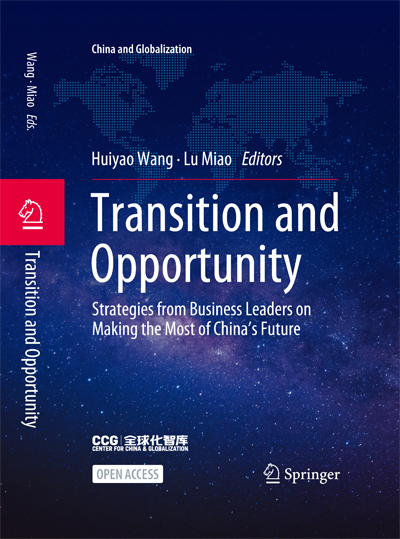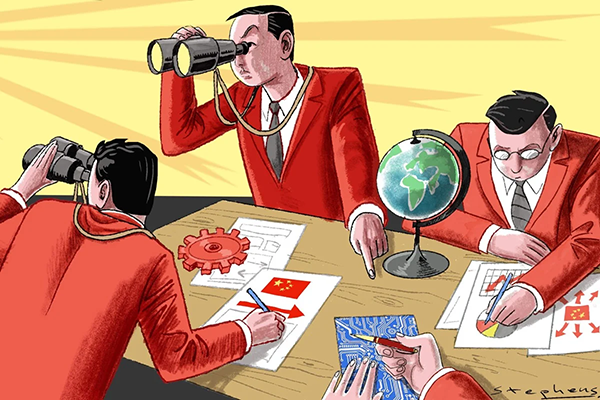Country Head of Daimler Greater China: The Remarkable Rise of Premium Automobiles in China
April 24 , 2022
 Hubertus Troska, Chairman & CEO of Daimler Greater China
Hubertus Troska, Chairman & CEO of Daimler Greater China
China has evolved at a breathtaking speed to become one of the most important players of the global economy. It’s is no surprise that the growth in Chinese car sales goes hand in hand with the rapid growth of wealth in Chinese society and China is now also the world’s most important market for premium car brands. Mercedes-Benz is growing “in China, with China” to understand Chinese requirements and pave the way for a future of mobility that is carbon neutral and meets the desires of consumers.
At the time of writing this article, I did not know the thoughts and stories other contributors will share in this book. However, given the extremely positive way in which many industries have developed in China in recent decades, I expect many success stories. Indeed, China has evolved at a breathtaking speed to become one of the most important players in the global economy. The story I would like to share in this context is how this development has played out for the business I work in—the automotive industry. Personally, I have been fortunate enough to be present for the latest chapter of this particular success story.
The importance of China has become especially evident in its resilience during the last global economic crises. In the economic and financial crisis of 2008 and 2009, it was China leading the world’s recovery. And during the recent COVID-19 pandemic, China bounced back faster than any other economy, providing stability for multinational companies around the globe. It has been impressive for me to see the vigor and speed with which China’s economy found its footing again during this period.
1 China—The Engine of the Global Car Industry
This holds especially true for the automotive industry. You can easily imagine this during a commute in any of China’s big cities nowadays. Car sales have evolved at a staggering pace in this country. Back in 2000, only about one million passenger cars were sold in China every year. Just 10 years later, that figure reached about 15 million vehicles. It was also about this time, China surpassed the USA as the world’s biggest automobile market. In 2020, one in every three cars sold worldwide was sold to a customer in China. Given the attractiveness of the Chinese market, almost every international car brand is also present in China, and Chinese consumers can choose from a wider variety of brands nowadays than customers in any other market in the world, and from both local and foreign manufacturers.
However, sheer numbers only begin to describe the impact that China has had on global car manufacturing. Cars hold a special place in consumer behavior. They tend to be among the most valuable goods we own, other than real estate, and more than most other commodities, they reflect our values and position in life. Thus, it is no surprise that the growth in Chinese car sales goes hand in hand with the rapid growth of wealth in Chinese society. As a result, China is now also the most important market for premium car brands in the world. During the pandemic in 2020, the premium auto market grew by almost 10% and the premium segment, as we define it, has outperformed the overall car market for the last 10 years. This is all the more impressive when you consider that just 15 years ago, the premium automobile market of the world’s most populous nation was smaller than in some European countries. Premium brands are leading the transformation of the automobile through their extensive efforts in research and development. Today, they all have a strong focus on the requirements of their customers in China.
I have lived in Beijing for more than eight years now, which has allowed me to experience firsthand the dynamics of this country and its market, and if there is anything I find even more fascinating than the sheer speed of market development here, it is the incredible potential for innovation. There is no doubt in my mind that China will play an important role in the future of our industry.
2 Making China Our Second Home
While Mercedes-Benz has a long history of success in many countries around the world, back in 2013, our market position in China was significantly behind our expectations. Our main competitors were selling significantly more, some even twice as many cars as we did. In terms of sales, the USA was the number one market for Mercedes-Benz passenger cars worldwide, followed by Germany. China only ranked third in our sales at the time. I remember intense discussions on our China strategy within the company. There was a strong conviction already at that time that China would play a major role in our global growth ambitions and success.
As a multinational company, there are different ways to be successful in a market. You can export to China from other countries or build plants and develop your local footprint in China.
3 Our Mindset: Grow in China, with China
I believe building a strong local footprint is an important factor for successfully doing business in China. Working closely together with Chinese partners, we have been expanding local production over the years, increasing R&D in China, developing good Chinese leaders and learning as a group every day how to better understand consumer preferences and their ambitions. It has been a long journey.
This approach has allowed Mercedes-Benz to make China our most important market worldwide. In 2020 alone, we set a new record with sales of almost 780,000 cars in China, making it by far the most important market in the world for Mercedes- Benz and one that is larger than our second and third largest markets combined. This corresponds to over a third of our worldwide car sales. Today, over three quarters of the Mercedes-Benz passenger cars we sell in this country are also produced here.
Getting to this point required developing an understanding of the distinct differences that exist between doing business in China and operating in other countries. Personally, I have learned a lot through this process and I know there is much more to learn. The measures we took were substantial. We worked with our partner to change our organizational structure, and we massively expanded our sales network. We adapted our brand positioning, and we also adjusted the way we develop our cars. Let me share a closer look into some of these aspects.
The particular characteristics of the Chinese car market start with the specific regulatory environment. For example, until recently, foreign enterprises were required to operate in joint ventures with Chinese companies. This is not common in most of our other country operations. However, from my own experience, I would say that it is a great advantage for a foreign company to have strong local partners in China. Not only on the production side but also on the retail side. The trusting relationship with our partners has helped us to understand the local market and the regulatory environment. This was the key to continuously increasing our local footprint and at the same time seizing mutually beneficial business opportunities together.
We started local production back in 2005 with our business sedan, the Mercedes- Benz E-Class. Original plans foresaw building about 25,000 cars annually in China. Today, that figure is almost 25 times higher, making our Beijing plant the biggest Mercedes-Benz plant in the world. And of course, the commitment to quality and the pursuit of excellence by our local team lives up to any comparison. As a result, as of today, more than three million vehicles have rolled off our assembly lines in Beijing. Production has expanded to include eight different passenger cars, including four long-wheelbase models exclusively designed for China and we intend to expand localization even further.
4 Creating a Deep Understanding of Chinese Requirements
Another unique aspect of operating in China is the specific technical regulations. This includes the quotas for cars with electrified drivetrains—so-called New Energy Vehicles (NEVs)—we have seen in recent years. Such measures have accelerated our general efforts to electrify our cars. Much sooner than in many other regions, customers in China have been able to enjoy favorable purchasing conditions and the necessary infrastructure for driving electric vehicles. This has led to significant growth rates for NEV sales.
There are many other ways in which we have seen specific product preferences in this market. For example, Chinese consumers are more likely to choose a sedan, SUV or coupé than in other markets where we see stronger preferences for hatchbacks, station wagons, pick-ups or cabriolets. At the same time, the customer base in China is distinctly younger than anywhere else around the globe. Readers from other parts of the world might be surprised to learn that the average Mercedes-Benz buyer in China is only 36 years old. In the USA, the average age of our customers is 52 years old. In our home market of Germany, it is 56. So there is almost an entire generation separating our customers in Germany and China. This, of course, strongly reflects their lifestyles and their preferences, particularly when it comes to digitalization and connectivity. Another interesting factor is that one third of our customers in China are first-time car buyers. This means that their Mercedes is the very first car they will ever own. This even applies to some of our top of the line S-class buyers.
We have been continuously working on adapting to these very specific circum- stances. Take our brand perception, for example. Chinese customers have extremely high expectations of premium brands, especially with regard to quality, technological innovation, connectivity and design. This is very much in line with our aspirations for Mercedes-Benz. This is summarized in our global brand claim “the best or nothing”. However, we have found that the positive connotations this brand claim holds in other parts of the world did not translate well into Chinese. It sounded somewhat detached and arrogant. So, we adapted the essence of the claim to the Chinese cultural context and adjusted it to read in English “an untiring spirit in pursuit of the best”.
In order to live up to this message, we have to create the most desirable cars, the most innovative technologies and the best customer services. One way of doing this is through our collaboration with local industry leaders, tech players and startups. We have created partnerships with several universities as well. At the same time, we have consistently expanded our local R&D footprint. Today, Daimler’s R&D hub in China is the most comprehensive outside Germany. Over 1,000 talented and mostly local people, are working on advanced design, electric mobility, intelligent connectivity or whole vehicle testing. Given our strong presence in terms of production and R&D, you could say that China has indeed become a second home for Mercedes-Benz. This also means that our future global product development is increasingly impacted by what we learn here.
5 Paving the Way to the Future of Mobility
As mentioned before, I believe that China will play an important role in the trans- formation of the global car industry. Connectivity and digitalization are excellent examples. Digital services have become an integral part of everyday life here much faster and to a much greater extent than in many other parts of the world. We can see an incredible amount of creativity and innovation in the development of Chinese consumer behavior, especially in the digital realm. This is why, for example, we have created dedicated teams in our R&D and marketing departments to create digital solutions in and around cars tailored to Chinese requirements.
It is evident that China will also play an important role in one of the most significant transformations our industry is undergoing right now—the shift to electric driving. China is already the world’s largest NEV market. And some of the world’s biggest suppliers for electric components are developing in China. I believe this development will gain momentum thanks to China’s aim to achieve carbon neutrality by 2060.
6 Shifting Gears Towards a Carbon–neutral Future
There is no doubt in my mind that we all have to contribute to drastically reduce CO2 emissions. Mercedes-Benz has announced that we will make our fleet CO2- neutral by 2039, which we call “Ambition 2039”. As a result, our vehicles will have no more relevant impact on inner-city air quality, improving the livability of cities around the world. By 2025, we will have about a dozen all-electric Mercedes Benz vehicles in our portfolio. We believe that the best way to make electric driving a commonplace reality is by giving our customers the world’s most desirable electric cars. Obviously, China will be crucial to our plans. By the time you read this article, we will have made substantial progress in electrifying our fleet. As of the end of 2021 alone, we have offered four all-electric vehicles in the market, three of which are built in China where we have also established local battery production. By 2030, every second Mercedes-Benz sold worldwide will be a plug-in hybrid or all-electric vehicle, potentially even more.
However, our so-called “Ambition 2039” plan does not only cover our vehicles. We follow a holistic approach, which means we aim for sustainable processes along all stages of the automotive value chain—from technical development to the extraction of raw materials, to production, service life and recycling. Our Chinese plants are prime examples. Thanks to an in-house photovoltaic system, our Shunyi plant in the north of Beijing has reduced CO2 emissions by 21,000 tons annually. Meanwhile, our BDA plant in the south of Beijing recycles more than one million liters of reclaimed water every day. Together with our Chinese suppliers, we are striving for battery cell production that is carbon neutral and uses certified raw materials.
All of this goes to show that the remarkable rise of premium automobiles in China is far from over. On the one hand, there is strong evidence that much of the growth we will see in global premium markets will continue to stem from China. On the other hand, we also expect to see an entirely new breed of premium cars that are fully autonomous, connected, fully electrified and strongly influenced by Chinese customers. I believe this to be a very positive outlook.
I have lived in several countries around the world since I was a child, but China holds a special place for me. It has truly become a second home for me personally and has changed my perspective on different aspects of life and business in many positive ways.
At the same time, my core understanding of business has remained the same. My personal conclusion, after working and living in China for many years, is that the central business principle in China is no different from that in the rest of the world. In the end, it all comes down to truly understanding and respecting your customers’ desires and aspirations. This is the starting point for forming an organization that is devoted to delighting customers with exciting products and services and proving to them that you are worthy of their trust—each and every day.
Hubertus Troska has been a member of the Board of Management (BoM) of Daimler AG since December 13, 2012. In this function, he is responsible for all Daimler’s business activities in Greater China (including Hong Kong, Macau and Taiwan) covering Passenger Cars, Vans, Trucks, New Energy Vehicles and Financial Services. As the highest level of management in Greater China, Mr. Troska has been appointed as chairman or board member of Daimler-owned subsidiaries or joint ventures in Greater China. Mr. Troska joined Daimler over 30 years ago. Through these years, he has served Daimler AG in various national and international management positions. Prior to his appointment in China, he was the Head of Mercedes-Benz Truck, President for Mercedes-AMG GmbH, and before that Head of Product Marketing Passenger Car Sales. He had also worked for Daimler in management positions in Turkey, the USA and Mexico.
// Editor’s note
Transition and Opportunity: Strategies from Business Leaders on Making the Most of China’s Future is the third book in the “China and Globalization” series, published in partnership with Springer Nature. The 22 essays contained in this volume are the work of a wide range of global experts in China’s business community. Contributors include the leaders of international chambers of commerce, CEOs and senior executives from leading MNCs and industry experts or country heads from global consulting firms. In a world of constant change and uncertainty where there is so much in doubt, these perspectives on the future of business in China, which are rooted in real-world experience and proven strategies that work, provide an immense trove of knowledge for those looking make the most of China’s bright future.

Transition and Opportunity
Editors: Huiyao Wang, Lu Miao
Published in February, 2022
Publisher: Springer Nature Publishing Group
Download Book at Springer
https://link.springer.com/book/10.1007/978-981-16-8603-0
Transition and Opportunity: Strategies from Business Leaders on Making the Most of China’s Future is the third volume in CCG’s “China and Globalization” series of books edited by Dr. Huiyao Wang and Dr. Lu Miao.

Series Editors: Huiyao Wang Lu Miao
Publisher: Springer Nature Publishing Group
Topical News See more






